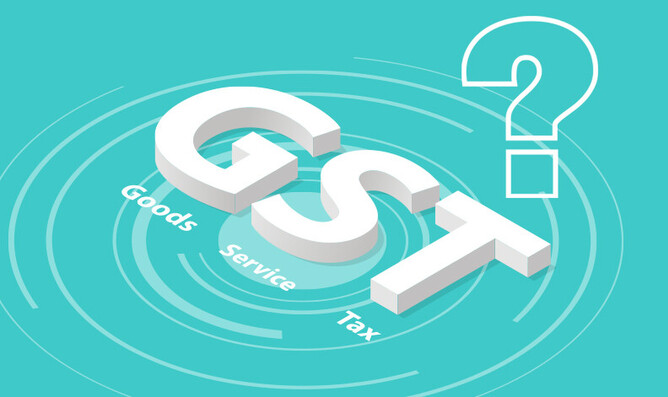The New Zealand government gets most of its revenue from taxes on:
- individual income
- business income
- goods and services
This article gives an overview of how GST (goods and services tax) works in New Zealand.
What is GST?
GST is a tax on goods and services.
Most things you buy have GST added to the price. You pay the GST to the seller and they pass it on to the IRD.
Some things you buy do not have GST added to the price.
For example:
- rent on a house or flat you live in
- airfares for overseas travel
- mortgage payments
How much is GST in NZ?
GST is charged at a rate of 15%.
If you regularly sell goods or services, you might need to charge GST to your customers.
Before you can charge GST you need to register for GST.
When you are GST registered you add GST to your prices and claim the GST back on your expenses. The net GST is passed on to the IRD.
How to calculate GST?
When adding 15% to the price it is relatively easy, just multiply the amount by 1.15.
For example, $100 x 1.15 = $115. This is the price inclusive of GST.
Reverse GST calculations are trickier.
To figure out how much GST was included in the price multiply the GST-inclusive price by 3 then divide by 23.
For example, $115 x 3 / 23 = $15
To work out the price without GST you have to divide the amount by 1.15
For example, $115 / 1.15 = $100
You can use one of our GST calculators to find GST inclusive and exclusive prices, or the correct GST content of a product or service.
How to become GST registered?
As soon as you think you’ll earn more than $60,000 in 12 months, you have to register for GST.
If you don't think you'll turn over that much, it's up to you whether to register for GST or not.
One benefit of voluntary GST registration is you might be able to claim a GST refund, e.g. if you have a lot of expenses but not much income.
You can register for GST on the IRD website here.
Filing GST returns
Once you have registered for GST, you have to complete regular GST returns.
During the GST registration process, you’ll be asked how often you want to file a GST return (frequency), and how you want account for GST (basis).
There are three frequency options, but they may not all be available to you.
- Monthly - businesses with more than $24 million in yearly turnover must file monthly
- Two-monthly - most small businesses are expected to file every couple of months
- Six-monthly - you can drop to twice-a-year returns if your annual turnover is less than $500,000
The IRD will put you on two-monthly filing frequency unless you choose otherwise. You can also change your filing frequency at any time, assuming you qualify for more than one.
There are also three basis options:
- Payments basis - you owe GST on a sale when you receive payment from a customer.
- Invoice basis - you owe GST on a sale when you raise an invoice or when you get paid, whichever comes first.
- Hybrid basis - you follow the invoice basis when working out what GST you owe, and the payments basis when working out what you can claim back. It can get quite complicated so it not recommended and only a few businesses use the hybrid basis.
If you’re using accounting software such as Xero to manage your business you can file your GST return directly through your accounting software to the IRD.
If you are not using accounting software you can file your GST return online using the IRD’s my GST service, a new section of myIR.
What can I claim GST back on?
You can claim a wide range of the expenses incurred as a result of operating your business provided you keep sufficient records and the expenses you are claiming have GST charged on them.
For goods and services costing more than $50, you must have a valid tax invoice when you claim the GST in your GST return.
But, for income tax purposes you are required to have a tax invoice/receipt for all expenses. So don’t go throwing away invoices and receipts for things under $50 thinking you don’t need them.
Some common expenses that don’t have GST charged on them are:
- Bank fees
- Donations
- Interest
- Non GST registered suppliers
- Overseas travel
- Some overseas suppliers (check your invoices, for example, Facebook charges GST while Adobe sometimes does not)
- Wages & salaries
GST due dates
Your GST due date will depend on when you registered, and your filing frequency.
If you file your GST return on a two-monthly basis and your GST returns are aligned with a March balance date, your due dates will be:
| • 15th January - Return and payment for the period ended November |
| • 28th February - Return and payment for the period ended January |
| • 7th May - Return and payment for the period ended March |
| • 28th June - Return and payment for the period ended May |
| • 28th August - Return and payment for the period ended July |
| • 28th October - Return and payment for the period ended September |
If you file your GST return on a six monthly basis and your GST returns are aligned with a March balance date, your due dates will be:
| • 7th May - Return and payment for the period ended March |
| • 28th October - Return and payment for the period ended September |
You may be penalised if you miss your deadline.
If you like some help staying on top of your GST return obligations then please don’t hesitate to contact us.



